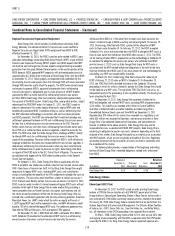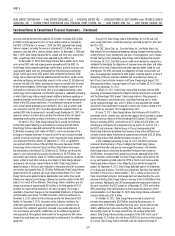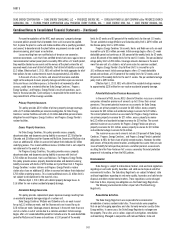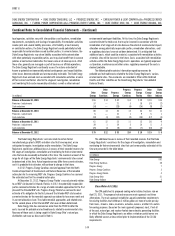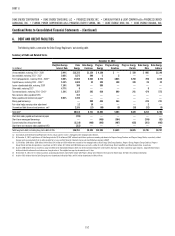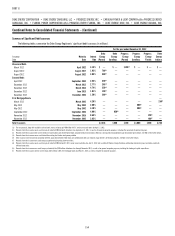Duke Energy 2012 Annual Report Download - page 165
Download and view the complete annual report
Please find page 165 of the 2012 Duke Energy annual report below. You can navigate through the pages in the report by either clicking on the pages listed below, or by using the keyword search tool below to find specific information within the annual report.
145
PART II
Combined Notes to Consolidated Financial Statements – (Continued)
DUKE ENERGY CORPORATION • DUKE ENERGY CAROLINAS, LLC • PROGRESS ENERGY, INC. • CAROLINA POWER & LIGHT COMPANY d/b/a PROGRESS ENERGY
CAROLINAS, INC. • FLORIDA POWER CORPORATION d/b/a PROGRESS ENERY FLORIDA, INC. • DUKE ENERGY OHIO, INC. • DUKE ENERGY INDIANA, INC.
The EPA plans to fi nalize the 316(b) rule by June 2013. Compliance with
portions of the rule could begin as early as 2016. Because of the wide range of
potential outcomes, including the other three alternative proposals, the Duke
Energy Registrants are unable to predict the outcome of the rulemaking or
estimate their costs to comply at this time.
Cross-State Air Pollution Rule (CSAPR).
On August 8, 2011, the fi nal Cross-State Air Pollution Rule (CSAPR) was
published in the Federal Register. The CSAPR established state-level annual
SO2 budgets and annual seasonal NOx budgets that were to take effect on
January 1, 2012.
Numerous parties challenged the rule. On August 21, 2012, by a
2-1 decision, the United States Court of Appeals for the District of Columbia
vacated the CSAPR. The court also directed the EPA to continue administering
the Clean Air Interstate Rule (CAIR) that the Duke Energy Registrants have
been complying with since 2009, pending completion of a remand rulemaking
to replace CSAPR with a valid rule. The CAIR requires additional reductions in
SO2 and NOx emissions beginning in 2015. The EPA petitioned for rehearing by
the Court of Appeals, which was denied. The EPA might seek review by the U.S.
Supreme Court. The CAIR will remain in force for an unknown period of time
until the EPA develops a replacement rule.
The Duke Energy Registrants cannot predict the outcome of any further
appeal or how a potential CSAPR replacement rule could affect future emission
reduction requirements. The continued implementation of the CAIR pending the
outcome of the rehearing process and a potential CSAPR replacement rulemaking
will not result in the Duke Energy Registrants adding new emission controls.
Coal Combustion Residuals (CCR).
On June 21, 2010, the EPA issued a proposal to regulate, under the Resource
Conservation and Recovery Act, coal combustion residuals (CCR), a term the EPA
uses to describe the coal combustion byproducts associated with the generation
of electricity. The EPA proposal contains two regulatory options whereby CCRs not
employed in approved benefi cial use applications either would be regulated as
hazardous waste or would continue to be regulated as non-hazardous waste. The
Duke Energy Registrants cannot predict the outcome of this rulemaking. The EPA has
stated that it may be 2014 before it fi nalizes the regulation.
Mercury and Air Toxics Standards (MATS).
The fi nal Mercury and Air Toxics Standards rule, previously referred to as
the Utility MACT Rule, was published in the Federal Register on February 16,
2012. The fi nal rule establishes emission limits for hazardous air pollutants
from new and existing coal-fi red and oil-fi red steam electric generating units.
The rule requires sources to comply with the emission limits by April 16, 2015.
Under the CAA, permitting authorities have the discretion to grant up to a 1-year
compliance extension, on a case-by-case basis, to sources that are unable to
complete the installation of emission controls before the compliance deadline.
The Duke Energy Registrants continue to develop and implement strategies
for complying with the rule’s requirements. Strategies to achieve compliance
with the fi nal MATS rules could include installing new or upgrading existing air
emission control equipment, developing monitoring processes, fuel switching
and accelerating retirement of some coal-fi red electric-generating units. For
additional information, refer to Note 4 regarding potential plant retirements.
Numerous petitions for review of the fi nal MATS rule have been fi led
with the United States Court of Appeals for the District of Columbia. The court
established a schedule for the litigation that has fi nal briefs being fi led on
April 8, 2013. Oral arguments have not been scheduled. The Duke Energy
Registrants cannot predict the outcome of the litigation or how it might affect the
MATS requirements as they apply to the Duke Energy Registrants. As disclosed
in the following table, the cost to the Duke Energy Registrants to comply with the
proposed MATS regulations will be material.
EPA Greenhouse Gas New Source Performance Standards (NSPS).
On April 13, 2012, the EPA published in the Federal Register its proposed
rule to establish carbon dioxide (CO2) emissions standards for pulverized
coal, IGCC, and natural gas combined cycle electric generating units that are
permitted and constructed in the future. The proposal would not apply to any
of the Duke Energy Registrants’ coal, including IGCC, and natural gas electric
generation plants that are currently under construction or in operation. Any
future pulverized coal and IGCC units will have to employ carbon capture and
storage (CCS) technology to meet the CO2 emission standard the EPA has
proposed. The proposed standard will not require new natural gas combined
cycle facilities to install CCS technology.
Management does not expect any material impact on the Duke Energy
Registrants’ future results of operations or cash fl ows based on the EPA’s
proposal. The fi nal rule, however, could be signifi cantly different from the
proposal. It is not known when the EPA might fi nalize the rule.
Estimated Cost and Impacts of EPA Rulemakings.
While the ultimate compliance requirements for the Duke Energy
Registrants for MATS, Clean Water Act 316(b) and CCRs will not be known
until all the rules have been fi nalized, for planning purposes, the Duke Energy
Registrants currently estimate that the cost of new control equipment that may
need to be installed on existing power plants to comply with EPA regulations
could total $5 billi on to $6 billion, excluding AFUDC, over the next 10 years. This
range includes estimated costs for new control equipment necessary to comply
with the MATS, which is the only rule that has been fi nalized, as shown in the
table below:
(in millions)
Duke Energy $650 to $800
Duke Energy Carolinas 65 to 85
Progress Energy 7 to 30
Progress Energy Carolinas 5 to 10
Progress Energy Florida 2 to 20
Duke Energy Ohio 40 to 85
Duke Energy Indiana 540 to 600
The Duke Energy Registrants also expect to incur increased fuel,
purchased power, operation and maintenance, and other expenses in
conjunction with these EPA regulations, and also expect to incur costs for
replacement generation for potential coal-fi red power plant retirements.
Until the fi nal regulatory requirements of the group of EPA regulations are
known and can be fully evaluated, the potential compliance costs associated
with these EPA regulatory actions are subject to considerable uncertainty.
Therefore, the actual compliance costs incurred may be materially different
from these estimates based on the timing and requirements of the fi nal EPA





